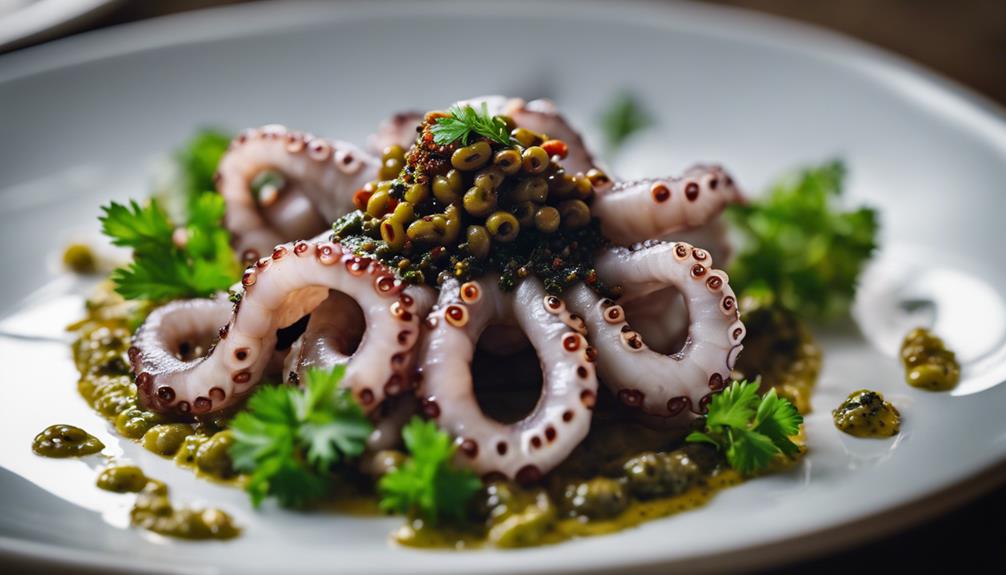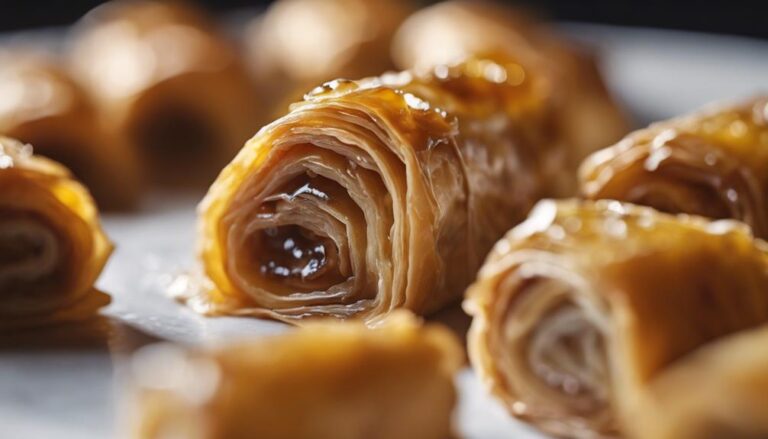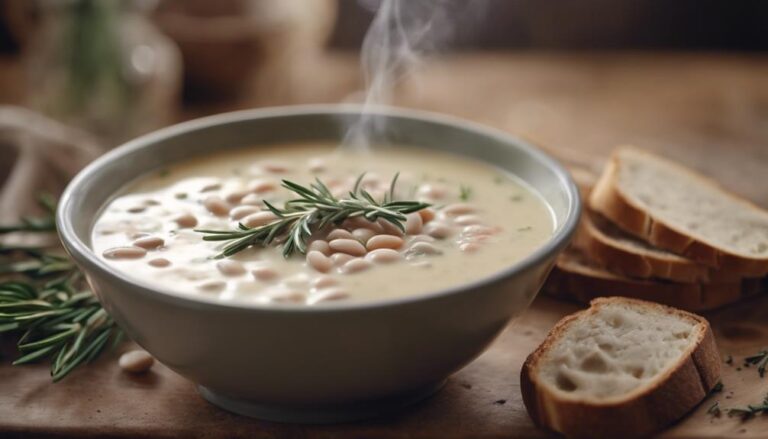Sous Vide Octopus With Olive Tapenade
Immerse octopus in a sous vide bath for tender perfection. Cook raw octopus at 171°F for 5 hours or 120°F for 2 hours if it's frozen. Sear the cooked octopus post-sous vide for added texture. Create a zesty olive tapenade with olives, capers, anchovies, and lemon. San Marzano tomatoes deepen the flavors. Searing enhances the dish with a crispy exterior and tender inside. Try this sophisticated dish for a culinary delight. Additional details about cooking temps and techniques can elevate your octopus experience.
What You Will Learn Here
- Sous vide octopus for tender texture before searing.
- Olive tapenade with olives, capers, and anchovies for flavor.
- Use lemon and San Marzano tomatoes to enhance taste.
- Searing adds crispy texture and caramelized flavor.
- Sous vide ensures octopus remains succulent and flavorful.
Sous Vide Origins
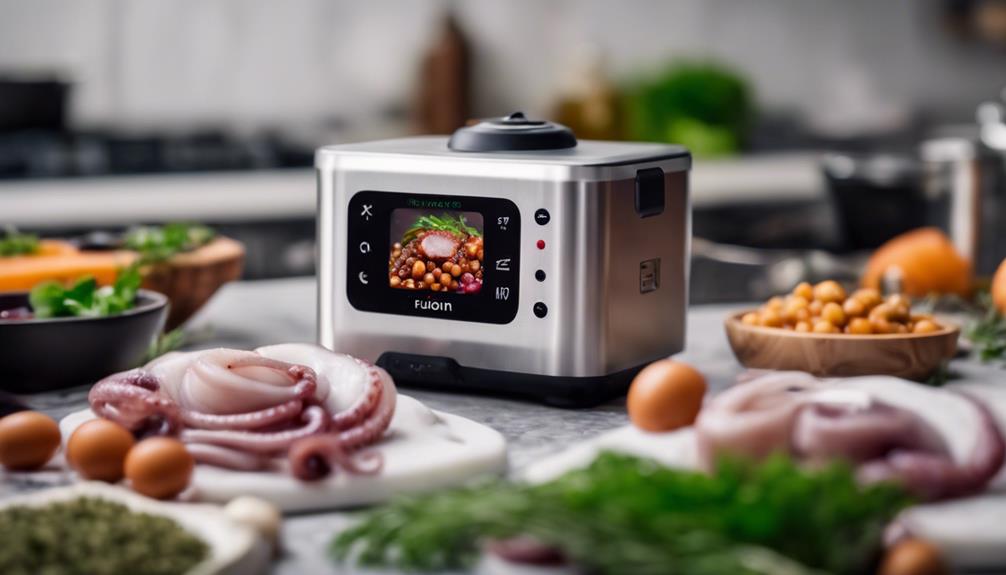
You've likely heard of sous vide, the French cooking technique with a rich history dating back to the 1970s.
Chef Georges Pralus is widely recognized as the pioneer behind this modern culinary method.
At its core, sous vide emphasizes precision temperature control, revolutionizing the way dishes are prepared and ensuring consistent, excellent results across various ingredients.
Sous Vide History
In the culinary world, the origins of sous vide cooking can be traced back to the innovative techniques developed in France during the 1960s. Sous vide, translating to 'under vacuum' in French, refers to the vacuum-sealed cooking method that revolutionized precision temperature control. Initially utilized in industrial food production, sous vide gained popularity thanks to Chef Georges Pralus, who introduced it to the culinary scene. This technique has since evolved into a staple in both professional kitchens and home cooking due to its ability to consistently deliver perfectly cooked dishes. Below is a table summarizing key points about the history of sous vide:
| Sous Vide History | |
|---|---|
| Origin | 1960s France |
| Popularizer | Chef Georges Pralus |
| Meaning | 'Under Vacuum' |
| Initial Use | Industrial food production |
| Evolution | Widely used in professional and home kitchens |
Modern Cooking Technique
Originating in the 1970s, the sous vide cooking technique was developed as a method for achieving precise temperature control in professional kitchens. Sous vide involves vacuum-sealing food in a bag and cooking it in a water bath at a consistent temperature. This modern cooking technique guarantees even cooking and ideal flavor retention in the food being prepared.
When preparing octopus with olive tapenade using sous vide, the octopus is first cooked in the water bath to achieve a tender texture. Once cooked, the octopus can be quickly seared in a hot pan to add a crispy outer layer before serving. This combination of sous vide cooking and searing allows for a perfect balance of tenderness and flavor in the dish.
Precision Temperature Control
For achieving precise temperature control in professional kitchens, the sous vide cooking technique, originating in the 1970s in France, involves vacuum-sealing food in a bag and cooking it in a water bath at a consistent, controlled temperature. Sous vide guarantees accuracy within tenths of a degree, allowing for perfect cooking outcomes.
By vacuum-sealing the food, flavors are intensified, and moisture is retained, resulting in tender and succulent dishes. The controlled temperature environment prevents overcooking, producing consistently excellent results. This method is particularly advantageous for delicate foods like octopus, where precise temperature control is essential for achieving the desired texture.
Sous vide cooking has revolutionized the culinary world, offering chefs and home cooks alike the ability to create restaurant-quality dishes with unparalleled precision and ease.
Sous Vide Tentacles Selection
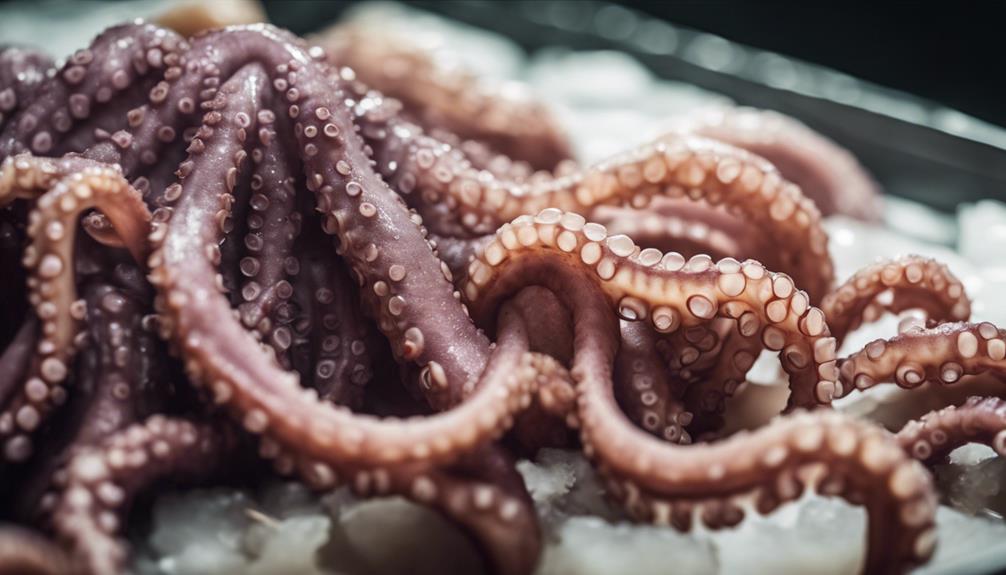
When selecting octopus tentacles for sous vide preparation, prioritize choosing specimens that exhibit a vibrant color, firm texture, and intact suckers. Here are some key points to take into account:
- Look for octopus legs that are a deep purplish hue, indicating freshness and quality.
- Confirm the tentacles have a slightly firm texture when gently pressed, a sign of peak freshness.
- Check that the suckers are all intact and show no signs of damage or deterioration.
Octopus Tapenade Recipe
When preparing your octopus tapenade, remember to include a blend of black and green olives, capers, anchovies, garlic powder, parsley, olive oil, and black pepper for a robust flavor profile.
The addition of lemon will provide a zesty, citrusy note to the tapenade, enhancing the overall taste of your sous vide octopus dish.
Consider using San Marzano whole peeled paste tomatoes to deepen the complexity of flavors in your tapenade.
Tenderizing Octopus With Sous Vide
To achieve ideal tenderness in octopus for your tapenade recipe, consider utilizing the sous vide cooking method at 170.5°F for 5 hours. This method tenderizes the octopus perfectly by breaking down collagen slowly, resulting in a melt-in-your-mouth texture.
When seared after sous vide, the octopus legs develop a flavorful crust that enhances the overall taste of your tapenade. The slow cooking process in sous vide guarantees that the octopus is defrosted and processed efficiently, maintaining its best tenderness throughout.
Using sous vide for your octopus tapenade recipe not only tenderizes the meat but also allows for precise control over the cooking process, ensuring a consistently delicious outcome every time.
Sous Vide Octopus Salad Recipe
For a captivating fusion of delicate octopus and lively olive tapenade, explore this exquisite Sous Vide Octopus Salad recipe.
- Submerge the octopus in a sous vide bath for prime tenderness.
- Prepare a flavorful olive tapenade with briny and savory notes.
- Combine the sous vide octopus and olive tapenade with fresh parsley for a burst of herbaceous flavors.
This Octopus Salad is a perfect blend of rich seafood and Mediterranean influences, creating a light and invigorating dish that's sure to impress. The sous vide cooking method guarantees the octopus is tender and succulent, while the olive tapenade adds a depth of flavor that complements the seafood beautifully. Enjoy the bright and vibrant flavors of this sophisticated salad.
Greek Octopus Salad Recipe
Consider incorporating a blend of tender octopus and flavorful olive tapenade in your culinary repertoire with this enticing Greek Octopus Salad Recipe.
- Grilled octopus, cooked to perfection, adds a smoky flavor to the dish.
- The tangy olive tapenade, made from olives, capers, and anchovies, provides a burst of Mediterranean flavors.
- The combination of the succulent grilled octopus and the savory tapenade creates a harmonious blend of textures and tastes, making each bite a delightful experience.
This Greek Octopus Salad showcases the versatility of octopus in Mediterranean cuisine, where the meaty seafood element of the octopus beautifully complements the briny, savory notes of the tapenade. It's an invigorating and satisfying dish that highlights the ability of octopus to enhance the flavors of other ingredients like olives and capers.
Octopus Sous Vide Temperature Guide
When cooking octopus sous vide, the temperature plays a vital role in achieving the desired texture. Different temperatures and cooking times can result in varied textures, from tender but firm to very tender and soft octopus.
It's essential to follow recommended temperature guidelines to guarantee your octopus turns out just the way you want.
Optimal Sous Vide Temperature
To achieve a tender and soft texture when cooking octopus sous vide, maintaining a precise temperature of 170.5°F (77°C) for 5 hours is ideal. Vacuum seal the octopus before submerging it in a water bath with temperature control to guarantee consistent heat distribution. Here is a table to illustrate the best sous vide temperature guide for octopus:
| Temperature (°F) | Temperature (°C) | Cooking Time |
|---|---|---|
| 170.5 | 77 | 5 hours |
| 185 | 85 | 24 hours |
| 140 | 60 | 24 hours |
Cooking Time Recommendations
For achieving optimum results when cooking octopus sous vide, maintaining the recommended temperature and cooking time is paramount to ensuring a tender and flavorful outcome. Set your vacuum sealer to 140°F (60°C) and allow the octopus to cook for a duration of 24 hours.
This precise combination of temperature and time will result in a texture that reveals the full potential of the octopus, striking the perfect balance between tenderness and firmness. By adhering to these guidelines, you'll reveal the full potential of the octopus, allowing it to reach its peak flavor and consistency.
Achieving Tender Octopus
Achieving perfect tenderness in your sous vide octopus hinges on the precise control of temperature, a fundamental element that profoundly influences the texture and flavor profile of this delicate seafood.
When cooking raw octopus sous vide, aim for 171°F for 5 hours to achieve best tenderness. However, if dealing with previously frozen octopus, a lower temperature of 120°F for 2 hours is recommended to reach the desired result.
To further enhance the flavor and texture, sear the cooked octopus on a hot cast iron surface quickly after sous vide. Remember, monitoring cook times is important for different types of octopus to achieve the desired tenderness.
Final Thoughts
In your culinary exploration, consider the harmonious blend of tender sous vide octopus and flavorful olive tapenade as a delightful conclusion to your gastronomic journey. The sous vide method has worked its magic on the octopus, ensuring a perfect texture that's both tender and full of flavor. The addition of the olive tapenade elevates the dish with its Mediterranean flair, adding a burst of savory and tangy notes that complement the delicate octopus meat beautifully.
Don't forget the final touch – searing the sous vide octopus to create a crispy exterior that contrasts wonderfully with the tender interior. This step not only adds a textural element to the dish but also enhances the overall flavor profile by introducing a caramelized, slightly charred note.
Whether you choose to slice the octopus, serve it whole, or even grill it for an extra smoky flavor, the combination of sous vide octopus and olive tapenade promises a unique and unforgettable culinary experience that will leave your taste buds singing with delight.
Frequently Asked Questions
How Long Does It Take to Sous Vide Octopus?
When sous vide cooking octopus, you can achieve ideal tenderness by cooking at 170.5°F for 5 hours. For previously frozen octopus, try 120°F for 2 hours. Experiment with longer cooking times at lower temps for varied textures.
What Is the Best Temperature to Cook Octopus?
For the best octopus texture using the sous vide method, aim for 170.5°F (77°C) for 5 hours for tender and firm results. Consider your cooking preferences; 140°F (60°C) for 24 hours yields tenderness, while 185°F (85°C) for 24 hours gives a softer texture.
How Do You Make Octopus More Tender?
To make octopus more tender, start by brining it for a few hours in a saltwater solution. Utilize tenderizing techniques like sous vide cooking or slow braising. Experiment with marinade options such as citrus, herbs, and olive oil for added flavor.
Do You Take the Skin off Octopus Tentacles?
When cooking octopus, removing the skin is optional. It impacts tenderness levels and texture. Some prefer the skin for added flavor, while others peel it off for a more tender result. Personal preference and cooking techniques play a role.
Conclusion
Indulge in the tender and flavorful sous vide octopus with olive tapenade, a dish that perfectly combines the delicate texture of octopus with the bold flavors of Mediterranean olives.
With the precise temperature guide for sous vide cooking, you can achieve a restaurant-quality dish right in the comfort of your own home.
Elevate your culinary skills and impress your guests with this exquisite and sophisticated seafood creation.
Bon appétit!
